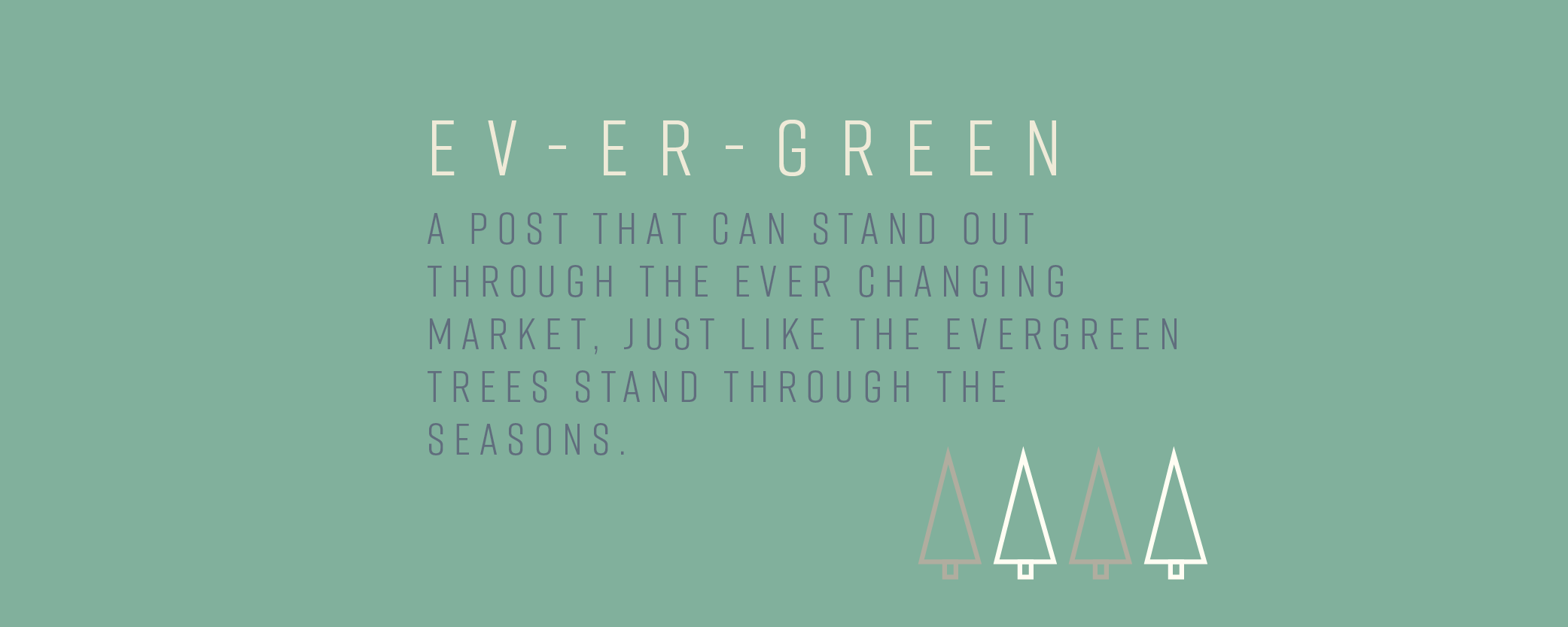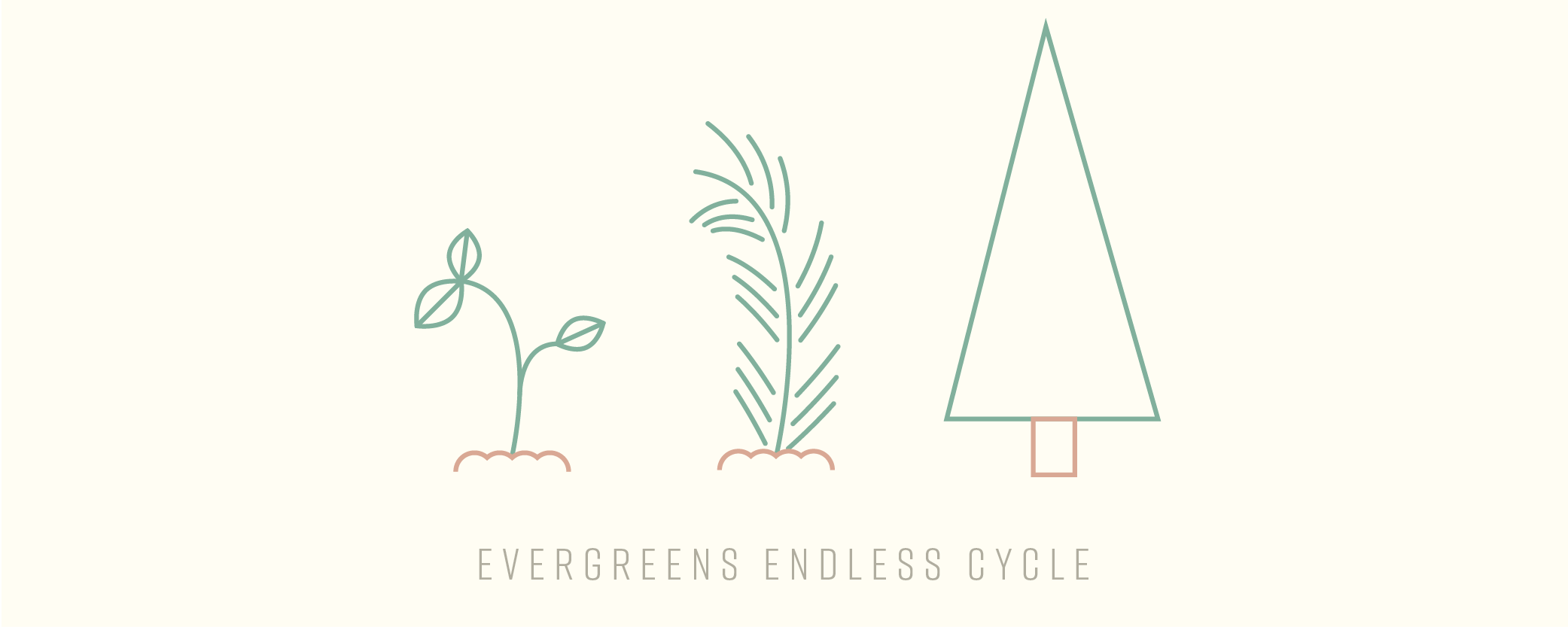What does “evergreen” mean, anyway?
Imagine a content strategy in which you can write fewer blog posts with a result of higher traffic flowing into the longer term...sound too good to be true? Well, it’s not—that strategy involves what are called evergreen posts.
Picture an evergreen tree, a never-shedding, sustaining model of perpetuity in nature, and now imagine a blog post with the same concept—minus the shedding, of course. Evergreen posts can be defined as posts that, long after being published, continue to gain both readers and search traffic alike.
An evergreen post is defined by two key characteristics: relevance and timelessness.
When a user types a question or topic into a search engine, the top hits are the most relevant, and the hits that stay at the top the longest are the most timeless. Posts that succeed in staying at the top of search results for the longest are, therefore, evergreen.
Although getting to that sweet spot is easier said than done, we'll highlight the main points of evergreen posts to help you incorporate them into your content strategy effectively.
So I wrote an awesome blog post, and now it’ll become evergreen, right? Not quite...

While the ultimate goal of a blog post is to attract readers, it is important to note that evergreen posts must first attract the right amount of attention from search engines. To achieve optimal results via SEO, there are many factors that can be influential, such as keyword use (but not abuse), providing alt text on images, the placement of evergreen posts, social sharing buttons, and frequent updates.
Make sure to do keyword research on the topic to ensure that it is being linked to popular and related searches; however, do not “stuff” the page with keywords—search engines have a sense for when a page feels like spam.
Alt text on an image is another factor that search engines will use to boost results, so always make sure that any images on a blog post you’d like to become evergreen are optimized via clear captions coded into every photo that’s included.
Although keywords and alt text increase the chances of a post becoming evergreen on the SEO side, it’s important to optimize your blog as well. Creating a section somewhere on the page with top posts or a captivating caption such as “start your adventure here” will help to get these posts noticed, increase the traffic to them, and consequently lead to those posts staying relevant, or evergreen.
Similarly, share buttons help to push the presence of your post beyond search engines and your blog alone, which in turn increases visibility in general across the internet, boosting your rankings and relevance overall.
Finally, a post that is supposed to be timeless cannot do so with outdated information, so it is important to regularly update evergreen posts not only to maintain relevance, but also to be favored in search engines’ algorithms.
Not just any type of post will do, however, so let’s highlight the most common forms of blog posts that tend to become evergreen and why.

How-to’s or Tutorials
So long as a process or concept, such as knitting a scarf, remains generally constant in our society, it’s easy to create step-by-step guides about such things that can be evergreen.
Think about it: when someone needs to know how to accomplish something, there’s a high chance they’ll ask the internet, so take advantage and provide useful how-to’s in your area of expertise to direct traffic to your blog.

Definitions and Glossaries
Gone are the days where people pulled the dictionary off the bookshelf to look up a word. The internet is quicker, easier, and keeps up with our rapidly-changing language.
Take this opportunity to create a list or glossary of definitions in your industry to provide beginners. Even as new words are added to our vocabulary, old ones are slow to leave, so it would be unlikely that this type of post could become obsolete for a while.

Tips
Tips, best practices, mistakes to avoid...a good way to establish credibility and increase blog traffic is by sharing insights from your industry. Not only will novices thank you for saving them the need for trial and error, but these posts stay relevant and timeless so long as the industry doesn’t take a sudden, sharp turn, making them a good candidate for becoming evergreen.
A good way to establish credibility and increase blog traffic is by sharing insights from your industry.

Lists
Similarly to tips, lists are a format that is usually successful in generating higher traffic. Whether the human attention span has shortened over the years, or our lives have simply become busier, lists are attractive to readers due to their short, sweet, and informative nature. Just make sure that the topic is popular and timeless first!

History or Archives
While history is fleeting and time perpetually pulls us forward, there are certain iconic moments in history, either public or private, that never lose their special touch. Articles about famous historic events or rare, old photos maintain their sense of timelessness as users reminisce or learn about a distant era that brought us to where we are today, and are therefore great for becoming evergreen.

Infographics and Videos
Evergreen posts don’t have to be written at all; in fact, a simple image or recording can be more valuable to a user than a whole page of text, depending on the topic. Don’t be afraid to try out different mediums. As social media becomes more about the visual elements than just textual, the chances of relevance and timelessness are increased when you emulate what’s popular. Create infographics that pack in useful information or processes, or try a video out as a more captivating and dynamic alternative to writing an article on a topic.
Best Practices

Writing posts in hopes of them becoming evergreen is a daunting task, so here are some tips to get you on the right track.
First, most posts that become evergreen are successful due to choosing the right audience: beginners. How often do experts in a field search for general information? We’d hope not too often. Posts that teach a user about the entry level of something are more optimal for becoming evergreen, so make sure you’re not spouting off too much highly technical, advanced information, or you may scare your less-qualified readers away.
Similarly, it’s difficult to narrow in too much on a topic and then hope it becomes evergreen because most searches are more broad than specific in nature. Make sure you’re speaking more generally on a topic to cast a wider net.
Another important factor is length: users are usually looking for quick and concise information, so avoid writing so much text that visitors bounce from your site simply from being overwhelmed. Even so, it's important to find a balance—search engines prefer longer, more in-depth content, so writing both shorter and longer articles will please Google and readers alike.
While every blogger’s dream is for every post to be evergreen, it is simply impossible and actually impractical: mixing your posts up allows you to cover timeless topics as well as trending ones, which will positively affect the traffic to the site in different ways—trends lead to sudden influxes in traffic while evergreen posts grow slowly and steadily. Not only that, but it allows you more freedom in the topics you could write about.
Although most articles require a publishing date, evergreen posts, as by their timeless nature, are an exception: including a date may actually do more harm than good by giving a user the option of initially assessing the content to be too old before giving it a chance.
Finally, it’s important to recognize the difference between evergreen and viral—think of them as the tortoise and the hare, though both win two entirely different races in this case. The timeline for a viral post is quite short: it’s created, exponentially gains traffic as it spreads like wildfire, then dies and goes to the internet graveyard just as quickly. Evergreen posts, however, may be slow to start, but gain long-term growth and experience slowly increasing traffic the whole time.
The kicker? If done right, evergreen posts never lose their importance, just as evergreen trees never lose their needles.




